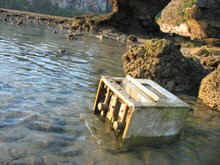Renewal on Ton Sai
Phra Nang, Krabi Province, Thailand
After a month away, I was surprised to see the face of Hat Ton Sai had changed significantly. Two new restaurants had sprung up where there had previously been only wreckage, travelers were beginning to return, a brand new concrete and glass tourist information booth was finished being rebuilt, and a host of new lights and decorations adorned the beachfront bars. Even the Freedom Bar had a new look to it, although they were still playing the same Bob Marley tracks as they were the day we left. Rai Leh and Phra Nang were obviously enjoying the influx of beach-goers as well. Numerous locals were able to re-open their shops and return to selling food, clothing, and jewelry on the beach.
Upon first arriving on Ton Sai three weeks after the tsunami, it was uplifting to hear the stories of how the climbers did not partake in the mass exodus after the destruction, but instead stayed to help. Many of those who were here on December 26th and who witnessed the devastation firsthand, pitched in to help clean the beaches and salvage what they could recover from the damage. It quickly became apparent however, that there was only so much the foreigners could do. More than one climber observed that it was obvious that some of the beachfront businesses had financial backing from elsewhere and were being quickly rebuilt, while many of the local operations had lost everything and had no means of recovering. It had reached the point where the Thais had to do things on their own.
“What were we going to do? It’s not like we could just go and rebuild their businesses for them?” said one climber who had escaped the wave by climbing a ladder on Ton Sai wall–next to the Freedom Bar–to gain the safety of a small ledge from which other climbs began. Climbers were offering to help, but several of the locals had simply given up and needed time to sort their lives out.

 Floating Bait Box Thai government has also thrown up some roadblocks for those wishing to help. It is their policy that volunteer work is still work, and therefore requires volunteers to apply for a work visa. Many of the aid organizations were sending volunteers away and only looking for those willing to make a long term commitment and who have specific skills. There are valid reasons for this though. Despite how the world media (especially North American) has been portraying it, Thailand suffered relatively minor damage when compared to Sri Lanka and parts of Sumatra. Those areas where aid is being concentrated are recovering quickly and well into the process of recuperating from what material damage was done.
Floating Bait Box Thai government has also thrown up some roadblocks for those wishing to help. It is their policy that volunteer work is still work, and therefore requires volunteers to apply for a work visa. Many of the aid organizations were sending volunteers away and only looking for those willing to make a long term commitment and who have specific skills. There are valid reasons for this though. Despite how the world media (especially North American) has been portraying it, Thailand suffered relatively minor damage when compared to Sri Lanka and parts of Sumatra. Those areas where aid is being concentrated are recovering quickly and well into the process of recuperating from what material damage was done.
Despite the obstacles, and in spite of the negative actions of some corporations and individuals, there are still plenty of people out there donating their time and money to families, hospitals, orphanages, and small villages off the beaten path. While formal aid is being focused on centers of tourism, many foreigners are digging deeper and giving where it is really needed. With any luck, the renewal on Ton Sai is being reflected in numerous places in Southeast Asia and every day will bring a bit of hope to those still lacking.
*Note: There is much debate about this due to the fact that places like the island of Phi Phi had become rather unsightly. Some say that Thailand has fairly generous squatter’s rights and, to use Ko Phi Phi again, some places were overwhelmed by Thais who squeezed in a small business where they could. Many argue that the Thai government is doing a good thing by attempting to not allow these areas to become as congested and ‘touristy’ as they once were.